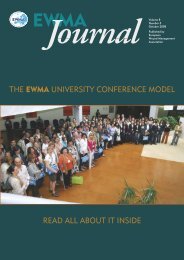FOCUS ON THE AUSTRIAN W UND ASSOCIATION - EWMA
FOCUS ON THE AUSTRIAN W UND ASSOCIATION - EWMA
FOCUS ON THE AUSTRIAN W UND ASSOCIATION - EWMA
- TAGS
- focus
- austrian
- association
- ewma
- ewma.org
Create successful ePaper yourself
Turn your PDF publications into a flip-book with our unique Google optimized e-Paper software.
Science, Practice and Education<br />
Figure 1: The first degree of tissue damage<br />
(straight edge without any cracks)<br />
Figure 3: The third wound trauma degree (deep crack) Figure 4: The third wound trauma degree (disrupted tissue)<br />
First, we analysed the distribution of TDD in the whole<br />
observation. We found a statistically significant difference<br />
between the TDD I, II and III (p = 0.0000) and also between<br />
the group with minimal tissue damage (TDD I) and<br />
the rest of the cohort (p = 0,00023) and between the maximum<br />
damage grade (TDD III) and the rest (0,00001), see<br />
table and graph 3a, 3b. Each group is unique and can be<br />
used to describe the properties of the whole group.<br />
The best results (the lowest occurrence of trauma<br />
markers), are achieved with the water-jet hydrosurgery<br />
technique (69%) and scalpel debridement (47%). In contrast,<br />
the greatest incidence of grade III trauma (the most<br />
severe signs of tissue trauma) were found in the group of<br />
tissue samples treated with scissors, method N (47%). A<br />
statistically significant difference in results was confirmed<br />
between the groups “V” and “N” (p=0.00005), “V” and<br />
“E” (P=0.00112), “N” and “S” (p=0.00049) and “N” and<br />
“E” (p=0.00035). Statistical analysis didn’t prove the statistically<br />
significant difference in wound trauma between<br />
the group “E” versus “S” (p=0.17404) and “V” versus “S”<br />
(p=0.17404).<br />
10<br />
Figure 2: The second wound trauma degree (small fissure)<br />
To establish a ranking of all the tested techniques we<br />
can calculate the average TDD (ATDD ) score, which<br />
takes into account not only the layout in each of the<br />
stages I-III, but also the significance of histopathological<br />
changes when assessing the impact of the relevant debridement<br />
technology on wound healing. According to this<br />
ATDD score, the best results (the least severe trauma) were<br />
achieved by group “V”, followed by groups “S” and “E”.<br />
The worst results (the heaviest histopathological changes<br />
on the surface due to wound trauma) were observed in<br />
group “N” (see table and graph No. 4).<br />
DISCUSSI<strong>ON</strong><br />
We observed 64 soft tissue specimens debrided with 4<br />
different surgical techniques in our experimental study.<br />
When planning the study we decided to make 2 independent<br />
histological sections from each tissue block to utilize<br />
the clinical material effectively. Thanks to this, we were<br />
able to increase the number of histological findings in<br />
<strong>EWMA</strong> Journal 2012 vol 12 no 1
















